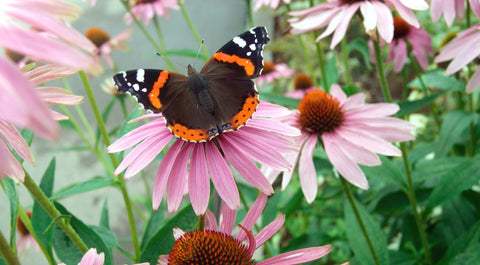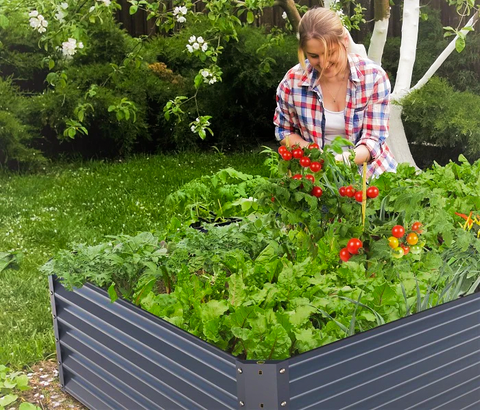Amidst growing concerns about water scarcity, the practice of gardening is evolving to meet the challenges of resource conservation. Drought-resilient gardening has emerged as an innovative and sustainable approach to cultivating vibrant gardens while minimizing water usage. When coupled with the benefits of raised beds, which offer improved drainage, enhanced soil structure, and efficient space utilization, this technique becomes even more effective. In this comprehensive guide, we'll delve into the world of water-saving strategies tailored for raised beds, showcasing how eco-friendly and high-quality materials can contribute to creating thriving gardens that are both visually appealing and environmentally responsible. The following content also has some reference value for raised garden beds.

The Synergy of Raised Beds and Water Efficiency
Before delving into water-saving techniques, it's essential to understand the inherent advantages of raised beds that make them conducive to drought-resilient gardening:
- Enhanced Soil Management: One of the key advantages of raised beds is their ability to provide better control over soil quality. These beds allow gardeners to tailor the soil composition to suit specific plant needs, leading to improved water retention and optimal drainage.
- Minimized Soil Compaction: Raised beds enable plant roots to grow more freely, reducing the risk of soil compaction. Loose soil structures facilitate water infiltration, preventing runoff, and enhancing the soil's ability to hold moisture.
- Precise Water Distribution: Watering in raised beds can be directed with precision, ensuring that the water reaches the plant's root zone where it's most needed. This accuracy minimizes water wastage and optimizes plant health.
- Reduced Weed Competition: The controlled environment of raised beds means fewer opportunities for weeds to take root. This reduction in weed competition not only saves water but also reduces the need for manual intervention.
Water-Saving Strategies for Raised Beds
1. Mulching Mastery
Mulching is a cornerstone technique for water conservation in raised beds. Applying a layer of organic mulch, such as straw, wood chips, or compost, offers a multitude of benefits:
- Moisture Retention: Mulch acts as a protective barrier that shields the soil from direct sun exposure, reducing evaporation. It maintains a consistently moist environment around the plant roots.
- Weed Suppression: A thick layer of mulch prevents weed growth by blocking sunlight. Weeds can compete with cultivated plants for water, so this aspect helps preserve water resources.
- Soil Temperature Regulation: Mulch moderates soil temperature, preventing extreme fluctuations that can lead to moisture loss. This regulation further contributes to water conservation.
2. Selecting Drought-Resistant Plants
Choosing the right plants for your raised beds is a pivotal step in drought-resilient gardening. Opt for plant varieties that are naturally adapted to thrive in your climate with minimal water requirements:
- Native Plants: Native plants are often well-suited to the local environment and possess natural resilience to water scarcity. They have evolved to thrive in the prevailing conditions, making them excellent choices for water-efficient gardening.
- Xeriscaping Plants: Xeriscaping plants, commonly found in arid regions, are designed to flourish with minimal water. Incorporating these plants into your raised beds can add aesthetic value while conserving water.
- Drought-Tolerant Varieties: Many plant species have cultivated varieties that are specifically bred for drought tolerance. Research and select these varieties for your raised beds to ensure a successful and water-efficient garden.
3. Strategic Companion Planting
Companion planting is a clever technique that involves placing compatible plants together to create mutually beneficial relationships:
- Tall and Short Plant Pairing: Pair tall, water-intensive plants with shorter, drought-tolerant companions. The taller plants provide shade to the shorter ones, reducing water loss through evaporation. This creates a microclimate conducive to water conservation.
- Herb-Flower Combinations: Combining herbs with flowering plants not only adds visual appeal but also contributes to water efficiency. Herbs like rosemary and lavender are known for their low water requirements, and their presence can reduce water usage for the entire bed.
- Nitrogen-Fixing Plants: Incorporate nitrogen-fixing plants like legumes into your raised beds. These plants improve soil fertility and structure, which in turn enhances water retention.
4. Efficient Watering Techniques
Watering efficiently is crucial in drought-resilient gardening. Implement these techniques to make the most of your water supply:
- Drip Irrigation: Drip irrigation delivers water directly to the base of plants, minimizing wastage from runoff or evaporation. It ensures that water reaches the roots where it's needed most, promoting healthy growth.
- Soaker Hoses: Soaker hoses lay on the soil surface and release water slowly along their length. This allows water to seep directly into the soil, preventing surface evaporation and runoff.
- Timely Watering: Watering during the early morning or late afternoon is optimal, as these times experience lower temperatures and reduced wind, which decrease water loss through evaporation.
5. Monitoring Soil Moisture
Investing in a moisture meter is a valuable tool for water-conscious gardeners:
- Data-Driven Watering: A moisture meter provides accurate readings of soil moisture levels, eliminating the guesswork from watering. This prevents overwatering, which can lead to water wastage and root rot.
6. Rainwater Harvesting
Harnessing rainwater for your garden is an eco-friendly and cost-effective method of water conservation:
- Rain Barrels: Install rain barrels to collect and store rainwater. This harvested water can be used for watering your raised beds during dry periods, reducing reliance on traditional water sources.
- Free of Chemicals: Rainwater is naturally free from the chemicals found in tap water, making it a healthier option for your plants.
7. Optimized Bed Layout
Strategically planning your raised bed layout can contribute to efficient water usage:
- Grouping Plants by Water Needs: Arrange your raised beds so that plants with similar water requirements are grouped together. This prevents overwatering some plants to accommodate others and ensures that each plant receives the appropriate amount of water.
8. Soil Enhancement for Water Retention
Amending your soil with organic matter is a proven method to enhance water retention:
- Compost Application: Incorporating compost into your soil improves its structure, enabling it to retain water more effectively. Compost also enriches the soil with essential nutrients, fostering healthy plant growth.
9. Regular Maintenance Practices
Consistent garden maintenance contributes to water efficiency:
- Weed Control: Regular weeding is essential as weeds compete with your cultivated plants for water. Removing weeds promptly ensures that water resources are dedicated to your desired vegetation.
- Pruning and Thinning: Overcrowded plants can create humid microenvironments that lead to water loss through evaporation. Pruning and thinning your plants maintains proper air circulation, reducing water wastage.
10. Cover Crops during Idle Periods
When your raised beds are not in active use, consider planting cover crops:
- Erosion Prevention: Cover crops protect the soil from erosion caused by wind and water, preserving its structure and water-holding capacity.
- Green Manure: Some cover crops, known as green manure, can be turned into the soil to improve its fertility and water retention when you're ready to plant again.

Conclusion
In the face of water scarcity and environmental challenges, adopting water-saving techniques for drought-resilient gardening is not only responsible but also rewarding. Raised beds, crafted from high-quality and eco-friendly materials, provide the ideal canvas for implementing these strategies. From mulching to efficient watering techniques, selecting the right plants to soil enhancement, each step contributes to a thriving garden that conserves water while showcasing innovative designs. By integrating these practices into your gardening routine, you're not only nurturing a sustainable oasis but also contributing to the greater goal of preserving our planet's precious water resources.









